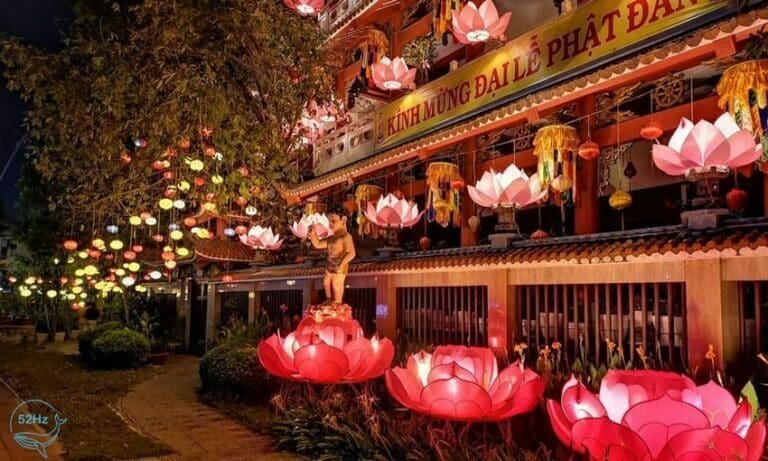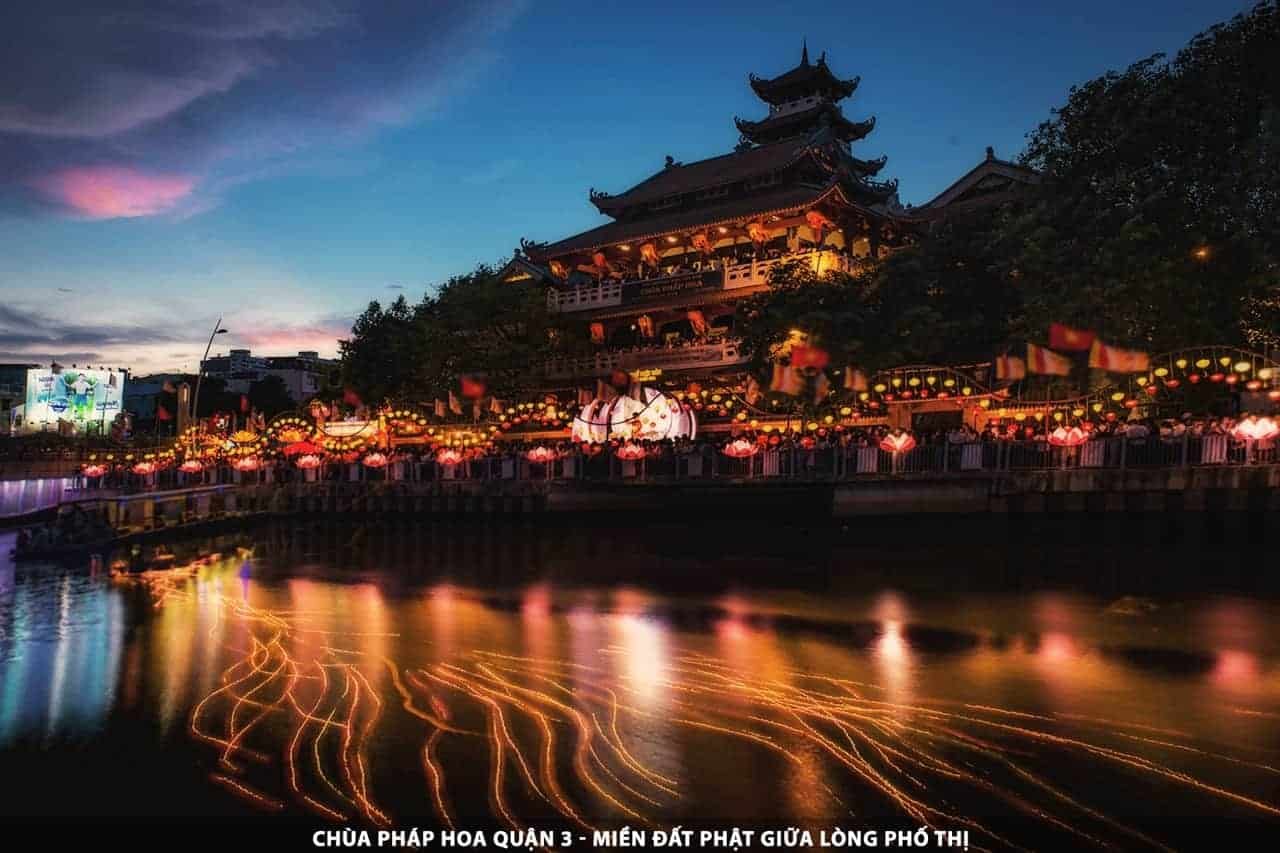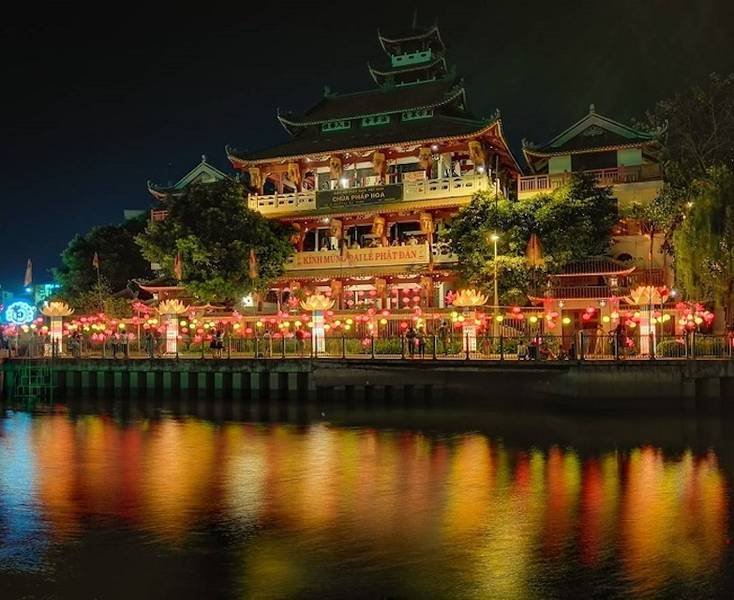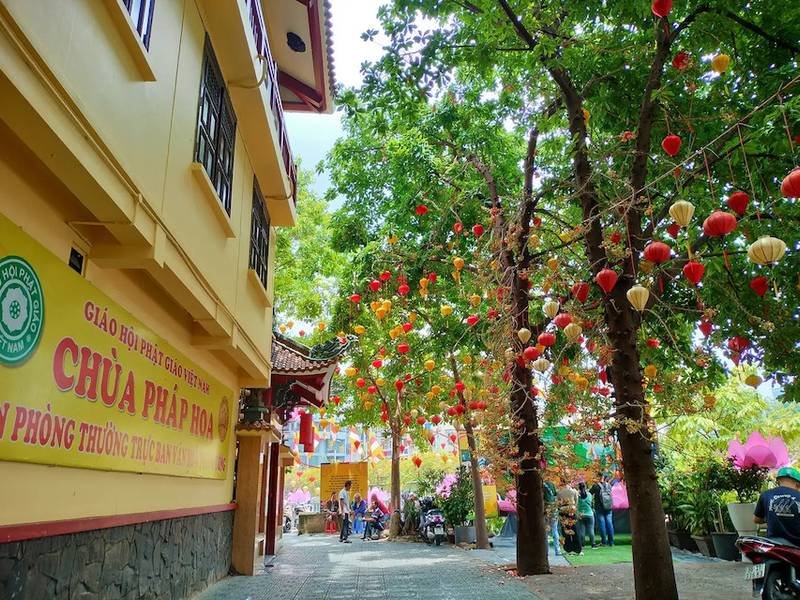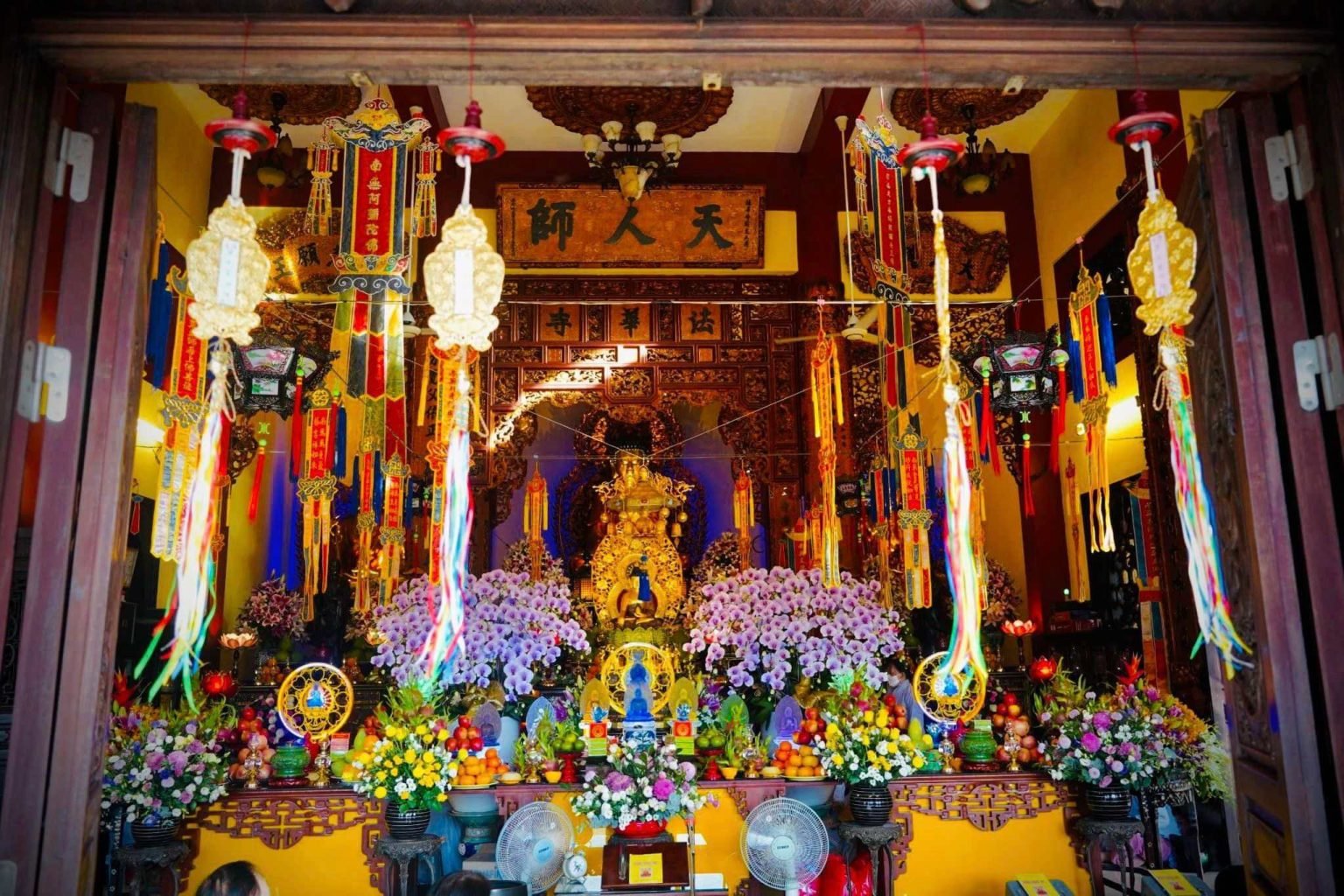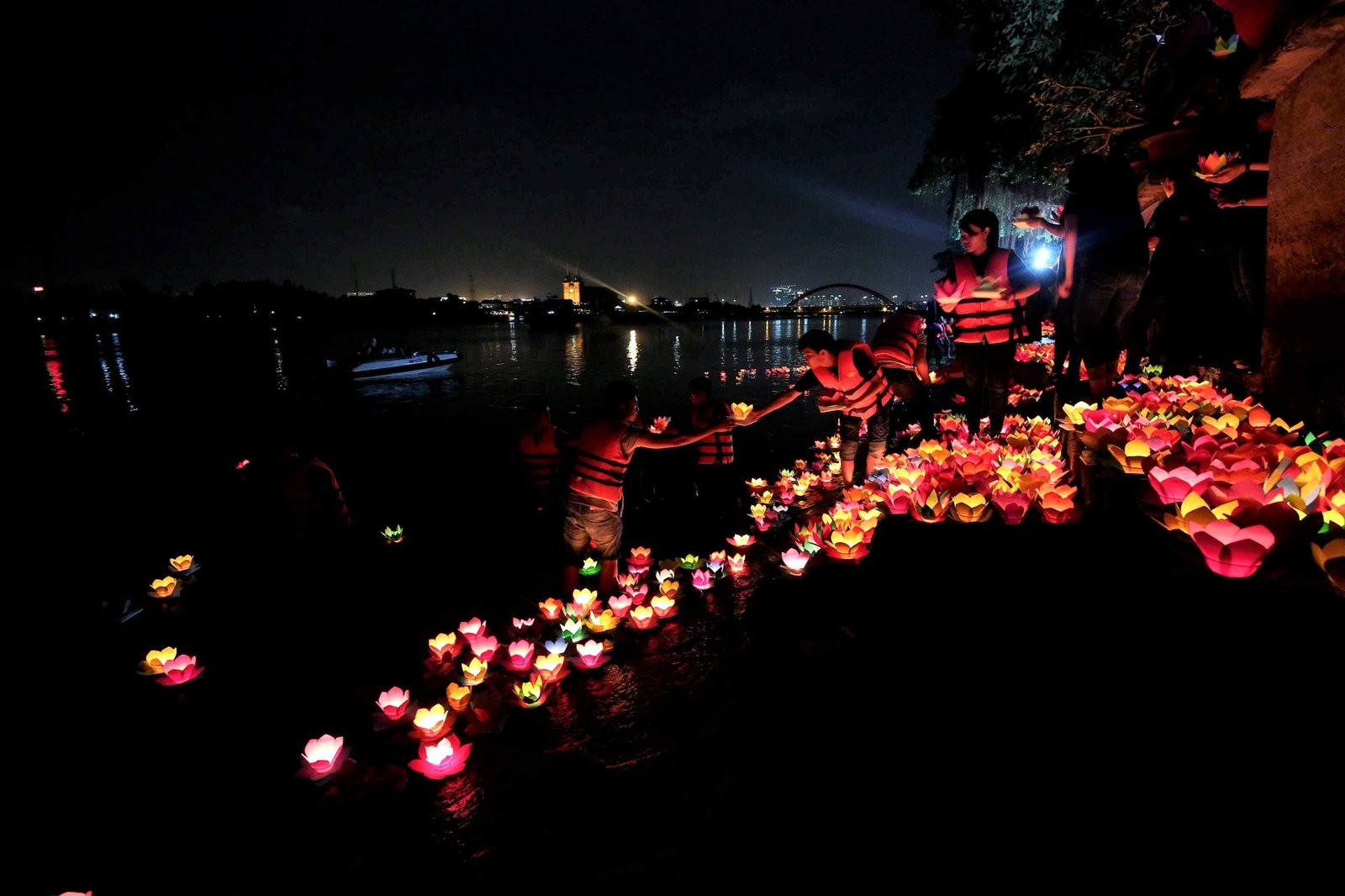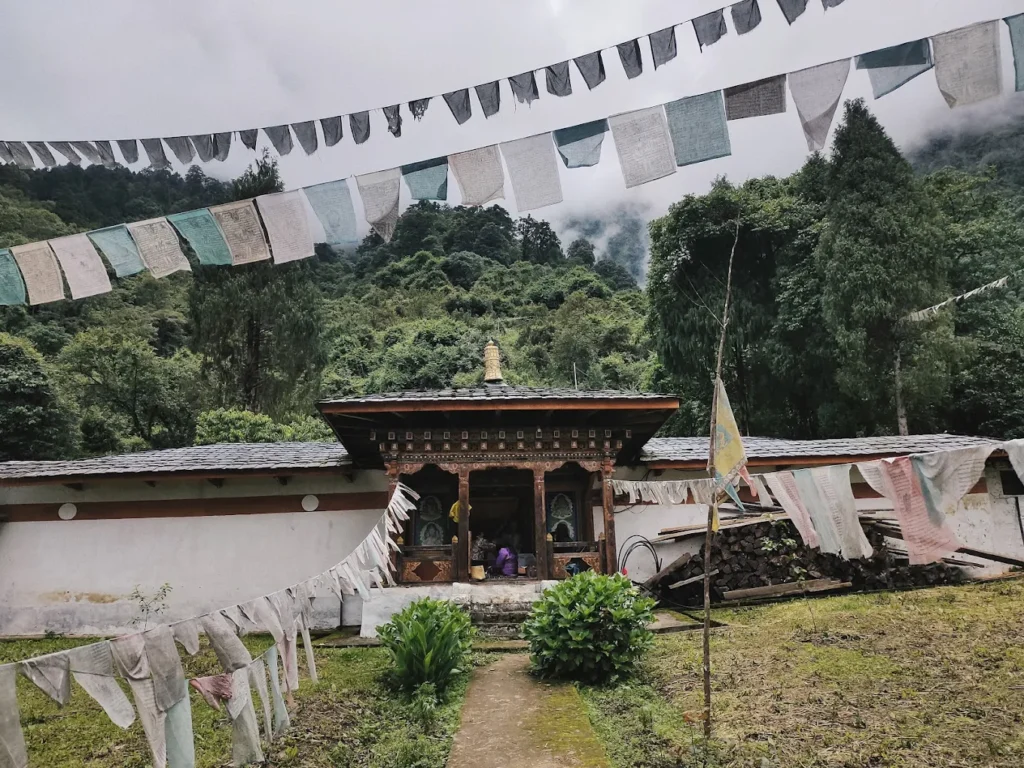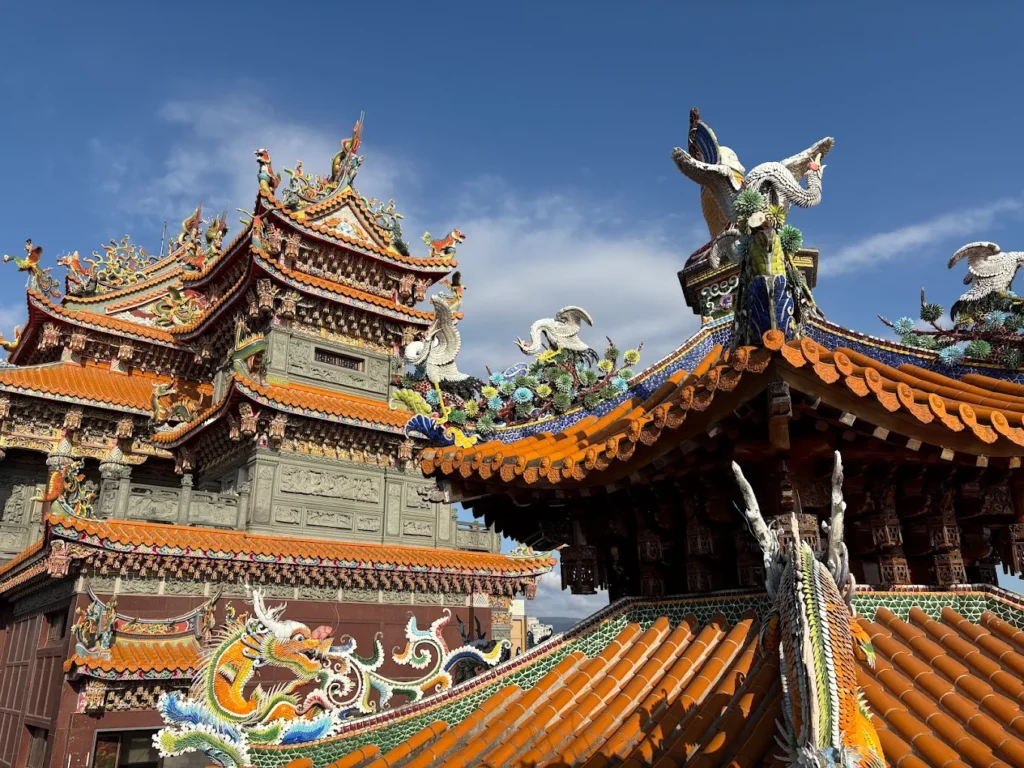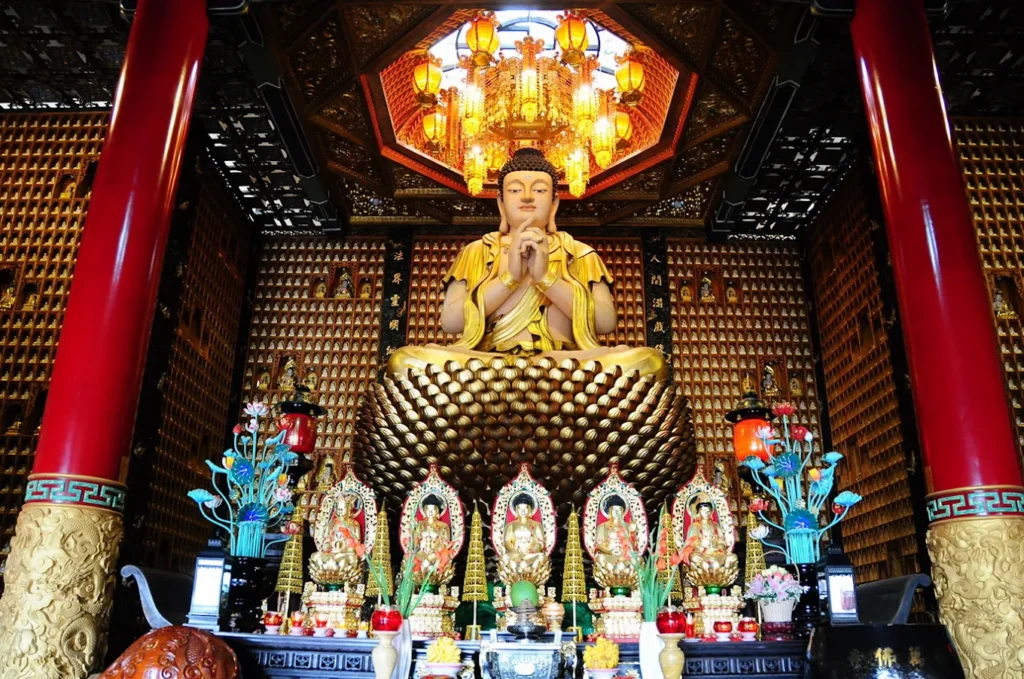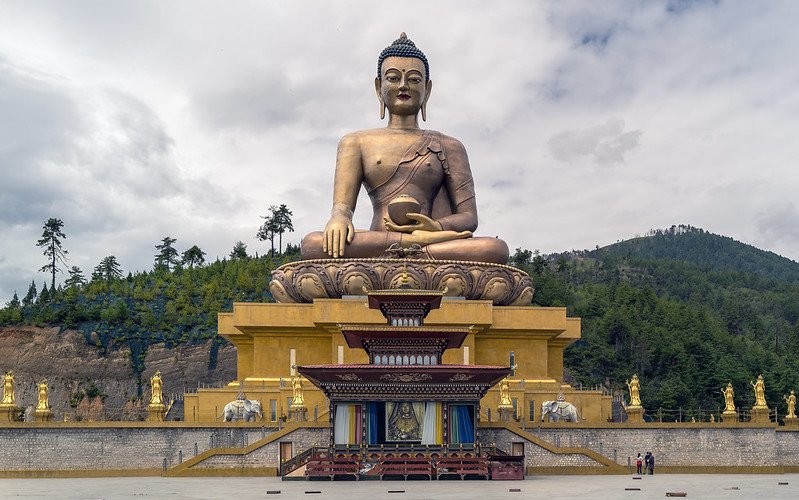Phap Hoa Pagoda: The Lotus-Lined Canal Retreat
As dusk settles over Ho Chi Minh City, Phap Hoa Pagoda (Chùa Pháp Hoa) glows beside the serene Nhiêu Lộc Canal, its red-tiled roofs catching the fading light. The air carries soft sutra chants, blending with the scent of sandalwood incense rising from altars where gilded statues, carved from jackfruit wood (gỗ mít), depict Shakyamuni Buddha (Phật Thích Ca Mâu Ni), the enlightened founder of Buddhism, and Avalokiteshvara (Bồ Tát Quán Thế Âm), the bodhisattva of compassion. During the Vesak Festival (Lễ Phật Đản), celebrating Buddha’s birth, enlightenment, and passing, the pagoda transforms into a radiant mosaic of lotus lanterns, their reflections dancing on the canal as thousands release flower lanterns in prayer. Founded in 1928 by a revered monk, this Northern Mahayana (Bắc Tông) sanctuary, a tradition emphasizing compassion and the bodhisattva vow to enlighten all beings, has cradled spiritual seekers and revolutionary heroes at 870 Trường Sa, its hidden 1945 bunker whispering Vietnam’s resilient spirit.
Overview and Significance
Phap Hoa Pagoda, located at 870 Trường Sa in District 3 (Quận 3), Ho Chi Minh City (Thành phố Hồ Chí Minh), stands as a cornerstone of the city’s spiritual and historical landscape. Its near-century legacy, woven with cultural vibrancy and revolutionary valor, draws pilgrims, travelers, and historians seeking solace and insight. This section traces its origins, cultural role, and enduring impact, grounding every detail in verified narratives.
Introduction to Phap Hoa Pagoda
Phap Hoa Pagoda, known as the Lotus Sanctuary for its serene elegance, offers a spiritual oasis beside Nhiêu Lộc Canal, contrasting Ho Chi Minh City’s urban clamor. Established in 1928, this Northern Mahayana temple has evolved from a modest structure to a revered landmark, recognized as a historical site in 2015 by the Ho Chi Minh City Department of Culture. Its Vesak Festival, where lotus lanterns illuminate the canal, marks it as a vibrant center of faith. The pagoda’s revolutionary past, including a 1945 bunker that sheltered cadres, adds historical depth, making it a symbol of devotion and resilience.
Historical Journey
The pagoda’s history reflects spiritual dedication and historical significance:
- Founding (1928): A revered monk established the pagoda in a simple wooden structure beside Nhiêu Lộc Canal, chosen for its tranquil setting to foster meditation and unity.
- Renovations: Upgrades in 1932 (red-tiled roofs), 1965, 1990, and 1993, supported by Buddhist devotees, enhanced its grandeur while preserving its essence.
- Revolutionary Role: In 1945, a secret bunker was built beneath the pagoda, serving as a hideout for revolutionary cadres during wartime.
- Historical Recognition (2015): The pagoda’s contributions earned it Historical Site status, cementing its place in Ho Chi Minh City’s heritage.
Cultural Significance
Phap Hoa Pagoda’s cultural role extends beyond religion:
- Spiritual Hub: It upholds Mahayana principles, fostering compassion through sutra recitation and meditation.
- Community Anchor: The Vesak Festival draws thousands, fostering unity and cultural pride.
- Historical Symbol: The 1945 bunker ties spirituality to Vietnam’s independence struggle.
Unique Legacy
The Vesak Festival, with lotus lantern releases, symbolizes purity and enlightenment. The bunker blends spiritual sanctity with national pride, distinguishing the pagoda as a cultural beacon.
Community and Global Impact
- Local Engagement: The pagoda hosts meditation, education, and charity, strengthening District 3’s social fabric.
- Diaspora Connection: Vietnamese Buddhists abroad visit during festivals, reinforcing cultural ties.
- Global Appeal: Recognized among Vietnam’s notable temples, it attracts international travelers.
Historical Anecdotes
- In 1945, monks sheltered revolutionaries in the bunker, balancing spiritual and patriotic acts.
- A wartime portrait remains a poignant relic of unity.
Social Role
The pagoda hosts educational sessions, charity drives, and community events, reinforcing societal welfare.
Artistic Influence
Inspired by traditional Vietnamese designs, the pagoda’s dragon motifs and jackfruit wood statues influence local artisans.
Transition to Architectural and Spiritual Features
From its storied past, Phap Hoa Pagoda’s physical form emerges as a testament to its legacy. The red-tiled roofs and jackfruit wood statues, set against Nhiêu Lộc Canal, invite exploration of its architectural splendor and sacred spaces.
Architectural and Spiritual Features
Phap Hoa Pagoda’s design reflects Northern Mahayana aesthetics, blending Vietnamese elements with spiritual symbolism. Its compact layout, centered around the main hall, harmonizes with the canal’s serene backdrop. This section explores its architecture, deities, and cultural influences.
Iconic Design
The pagoda follows a traditional Vietnamese Buddhist plan, with a three-gate entrance leading to a courtyard and main hall. Red-tiled roofs with dragon motifs symbolize protection, while the canal enhances meditative ambiance.
Key Structures
- Three-Gate Entrance: A triple-arched gate with floral carvings welcomes visitors.
- Main Hall: The spiritual core, housing altars, features wooden beams and tiled floors.
- Courtyard: A serene space with lotus ponds, used for festivals.
- Bunker (1945): A hidden chamber, now a historical relic.
Worshipped Statues/Deities
The main hall enshrines:
- Shakyamuni Buddha: A gilded jackfruit wood statue, depicting meditation, symbolizes enlightenment.
- Avalokiteshvara: A standing statue radiates compassion.
- Ksitigarbha (Bồ Tát Địa Tạng): A seated figure represents vows to save suffering beings.
Materials and Techniques
Built with jackfruit wood and red tiles, the pagoda showcases Vietnamese craftsmanship. Artisans carved dragon reliefs, blending Mahayana symbolism with regional aesthetics.
Signature Elements
Lotus lanterns during Vesak adorn the courtyard, symbolizing purity. The bunker’s entrance, marked by a plaque, underscores the pagoda’s revolutionary legacy.
Lesser-Known Features
- Inscribed Pillars: Wooden columns bear sutra verses.
- Lotus Pond: A small pond enhances the meditative setting.
Preservation Efforts
Renovations in 1990 and 1993 addressed canal water damage, preserving original designs.
Environmental Integration
The canal’s flow reflects the pagoda’s serene layout, enhancing spiritual harmony.
Artisan Narratives
Local craftsmen contributed to renovations, passing down woodcarving techniques.
Symbolic Details
Dragon motifs symbolize protection, lotus imagery reflects purity.
Landscape Integration
The canal and trees provide a tranquil setting for meditation.
Transition to Rituals and Practices
The pagoda’s sacred spaces support its vibrant spiritual life. These architectural elements frame the rituals that define Phap Hoa Pagoda’s role as a center of Northern Mahayana practice.
Rituals and Practices
Phap Hoa Pagoda’s spiritual practices, rooted in Northern Mahayana Buddhism, center on compassion and enlightenment. This section details verified rituals, emphasizing the Vesak Festival.
Daily Sacred Rites
- Sutra Chanting: Monks recite the Lotus Sutra mornings, fostering mindfulness.
- Offerings: Devotees present sandalwood incense and flowers, honoring Shakyamuni Buddha.
- Meditation: Evening sessions promote inner peace.
Unique Practices
Vesak preparations include crafting lotus lanterns, symbolizing purity.
Festival Traditions
- Vesak Festival: Held in May, it features:
- Lantern Processions: Thousands carry lotus lanterns.
- Flower Releases: Lanterns float on Nhiêu Lộc Canal, symbolizing prayers.
- Dharma Talks: Monks share teachings on compassion.
Visitor Engagement
Visitors can:
- Join sutra chanting with guidance.
- Participate in lantern-making during Vesak.
- Offer incense, following Mahayana etiquette.
Spiritual Community Roles
Monks lead rites, lay devotees organize festivals and charity.
Interfaith Connections
The pagoda hosts occasional interfaith dialogues, reflecting Mahayana inclusivity.
Ritual Symbolism
Lotus lanterns symbolize purity, incense represents impermanence.
Seasonal Variations
Rituals intensify during Vesak and Lunar New Year with added chanting.
Monastic/Community Life
Monks maintain meditation and study, devotees volunteer.
Transition to Visitor Information
The pagoda’s rituals invite visitors to engage with its practices. Understanding logistics ensures a meaningful experience, blending reverence with exploration.
Visitor Information
Phap Hoa Pagoda welcomes travelers with practical logistics and immersive opportunities. This section provides verified details on access and etiquette.
Navigating to Phap Hoa Pagoda
Located at 870 Trường Sa, Ward 14, District 3, Ho Chi Minh City, the pagoda is near Lê Văn Sĩ Bridge along Nhiêu Lộc Canal.
Address of Phap Hoa Pagoda
- English: 870 Trường Sa, Ward 14, District 3, Ho Chi Minh City, Vietnam
- Vietnamese: 870 Trường Sa, Phường 14, Quận 3, Thành phố Hồ Chí Minh
Visiting Hours and Etiquette
- Hours: 6:00 AM–8:00 PM daily, extended during Vesak.
- Etiquette:
- Dress modestly.
- Remove shoes in the main hall.
- Speak softly.
- Ask permission before photographing monks.
Transport Options
- Taxi: 15 minutes from District 1.
- Motorbike: Ample parking.
- Foot: Short walk from Lê Văn Sĩ Bridge.
Accessibility and Safety
- Accessibility: Courtyard is wheelchair-accessible, main hall has steps.
- Safety: Safe area, but avoid valuables during festivals.
Amenities and Surroundings
Restrooms and seating available; nearby cafes offer local cuisine.
Immersive Visitor Tips
- Visit during Vesak for lantern processions.
- Join morning sutra chanting.
- Explore the bunker with a guide.
Nearby Cultural Experiences
- Vĩnh Nghiêm Pagoda: 10 minutes away.
- War Remnants Museum: 15-minute drive.
Photography Tips
- Capture lanterns at dusk.
- Avoid flash in the main hall.
Transition to Cultural and Spiritual Insights
Visiting Phap Hoa Pagoda opens a gateway to its spiritual depths. Its philosophical and symbolic elements reveal the heart of Northern Mahayana Buddhism.
Cultural and Spiritual Insights
Phap Hoa Pagoda’s significance extends to its philosophy and community resilience. This section explores verified beliefs and narratives.
Religious Philosophy
Northern Mahayana emphasizes compassion and the bodhisattva path, with teachings on mindfulness and charity.
Environmental Spirituality
The canal’s flow mirrors Buddhist impermanence, encouraging meditation.
Artistic Symbolism
Lotus lanterns and dragon motifs reflect purity and protection.
Community Resilience
The pagoda’s wartime role showcases Buddhist compassion.
Environmental Stewardship
Devotees maintain canal cleanliness, aligning with Buddhist respect for nature.
Meditative/Contemplative Practices
Guided meditation fosters inner peace.
Cultural Narratives
Founding legends highlight the pagoda’s role as a refuge.
Historical Context
The bunker ties the pagoda to Vietnam’s independence.
